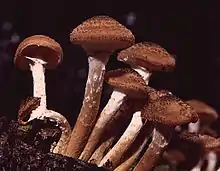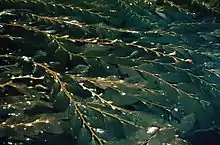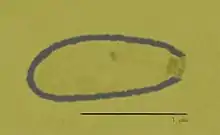Largest organisms
The largest organisms now found on Earth can be determined according to various aspects of an organism's size, such as: mass, volume, area, length, height, or even genome size. Some organisms group together to form a superorganism (such as ants or bees), but such are not classed as single large organisms. The Great Barrier Reef is the world's largest structure composed of living entities, stretching 2,000 km (1,200 mi), but contains many organisms of many types of species.

This article lists the largest species for various types of organisms and mostly considers extant species. The organism sizes listed are frequently considered "outsized" and are not in the normal size range for the respective group.
If considered singular entities, the largest organisms are clonal colonies which can spread over large areas. Pando, a clonal colony of the quaking aspen tree, is widely considered to be the largest such organism by mass.[1] Even if such colonies are excluded, trees retain their dominance of this listing, with the giant sequoia being the most massive tree.[2] In 2006 a huge clonal colony of Posidonia oceanica was discovered south of the island of Ibiza. At 8 kilometres (5 mi) across, and estimated at around 100,000 years old,[3] it may be one of the largest and oldest clonal colonies on Earth.[4][5][6]
Among animals, the largest species are all marine mammals, specifically whales. The blue whale is believed to be the largest animal to have ever lived. The largest land animal classification is also dominated by mammals, with the African bush elephant being the largest of these.
Plants
The largest single-stem tree by wood volume and mass is the giant sequoia (Sequoiadendron giganteum), native to Sierra Nevada and California; it typically grows to a height of 70–85 m (230–280 ft) and 5–7 m (16–23 ft) in diameter.
The largest organism in the world, according to mass, is the aspen tree whose colonies of clones can grow up to 8 kilometres (5 mi) long. The largest such colony is Pando, in the Fishlake National Forest in Utah.
A form of flowering plant that far exceeds Pando as the largest organism on earth in area and probably also mass, is the giant marine plant, Posidonia australis, living in Shark Bay, Australia. Its length is about 180 km (112 mi) and it covers an area of 200 km2 (77 sq mi).[7][8] It is among the oldest known clonal plants too.
Another giant marine plant of the genus Posidonia, Posidonia oceanica discovered in the Mediterranean near the Balearic Islands, Spain may be the oldest living organism in the world, with an estimated age of 100,000 years.[9]
The largest individual flower in the world is Rafflesia arnoldii, while the flowering plant with the largest unbranched inflorescence in the world is Amorphophallus titanum, both are native to Sumatra island of Indonesia.
Green algae
Green algae are photosynthetic unicellular and multicellular protists that are related to land plants. The thallus of the unicellular mermaid's wineglass, Acetabularia, can grow to several inches (perhaps 0.1 to 0.2 m) in length. The fronds of the similarly unicellular, and invasive Caulerpa taxifolia can grow up to a foot (0.3 m) long.
Animals
The largest animal ever to have lived is thought to be the blue whale (Balaenoptera musculus). The maximum recorded weight was 190 tonnes for a specimen measuring 27.6 metres (91 ft), whereas longer ones, up to 33.6 metres (110 ft), have been recorded but not weighed.[10][11][12] It is estimated however that this individual could have a mass of 250 tonnes.[13][14] The title of the longest non-colonial animal is probably owned by Lion's mane jellyfish (36.6m / 120 ft).[15]
The African bush elephant (Loxodonta africana) is the largest living land animal. A native of various open habitats in sub-Saharan Africa, this elephant is commonly born weighing about 100 kilograms (220 lb).[16] The largest elephant ever recorded was shot in Angola in 1974. It was a male measuring 10.67 metres (35.0 ft) from trunk to tail and 4.17 metres (13.7 ft) lying on its side in a projected line from the highest point of the shoulder to the base of the forefoot, indicating a standing shoulder height of 3.96 metres (13.0 ft). This male had a computed weight of 12.25 tonnes.[10]Fungi

The largest living fungus may be a honey fungus[17] of the species Armillaria ostoyae.[18] A mushroom of this type in the Malheur National Forest in the Blue Mountains of eastern Oregon, U.S. was found to be the largest fungal colony in the world, spanning 8.9 km2 (2,200 acres) of area.[19][20] This organism is estimated to be 2,400 years old. The fungus was written about in the April 2003 issue of the Canadian Journal of Forest Research. While an accurate estimate has not been made, the total weight of the colony may be as much as 605 tons. If this colony is considered a single organism, then it is the largest known organism in the world by area, and rivals the aspen grove "Pando" as the known organism with the highest living biomass. It is not known, however, whether it is a single organism with all parts of the mycelium connected.[20]
A spatial genetic analysis estimated that a specimen of Armillaria ostoyae growing over 91 acres (37 ha) in northern Michigan, United States weighs 440 tons (4 x 105 kg).[21][22] Approximations of the land area of the Oregon "humongous fungus" are 3.5 square miles (9.1 km2) (2,240 acres (910 ha), possibly weighing as much as 7,500 tons as the world's most massive living organism.[23]
In Armillaria ostoyae, each individual mushroom (the fruiting body, similar to a flower on a plant) has only a 5 cm (2.0 in) stipe, and a pileus up to 12.5 cm (4.9 in) across. There are many other fungi which produce a larger individual size mushroom. The largest known fruiting body of a fungus is a specimen of Phellinus ellipsoideus (formerly Fomitiporia ellipsoidea) found on Hainan Island.[24] The fruiting body masses up to 500 kg (1,100 lb).[25][26]
Until P. ellipsoideus replaced it, the largest individual fruit body came from Rigidoporus ulmarius. R. ulmarius can grow up to 284 kg (626 lb), 1.66 m (5.4 ft) tall, 1.46 m (4.8 ft) across, and has a circumference of up to 4.9 m (16 ft).
Lichen
Umbilicaria mammulata is among the largest lichens in the world. The thallus of U. mammulata is usually 4 to 15 cm (1.6 to 5.9 in) in diameter, but specimens have been known to reach 63-centimetre (2.07 ft) in the Smoky Mountains of Tennessee.[27]
The longest lichen is Usnea longissima, which may grow to exceed 20 feet in length.[28]
Protists

(Note: the group Protista is not used in current taxonomy.)
Amoebozoans (Amoebozoa)
- Among the organisms that are not multicellular, the largest are the slime molds, such as Physarum polycephalum, some of which can reach a diameter over 30 cm (12 in).[29] These organisms are unicellular, but they are multinucleate.
Euglenozoans (Euglenozoa)
- Some euglenophytes, such as certain species of Euglena, reach lengths of 400 μm.[30]
Rhizarians (Rhizaria)
- The largest species traditionally considered protozoa are giant amoeboids like foraminiferans. One such species, the xenophyophore Syringammina fragilissima, can attain a size of 20 cm (7.9 in).[31]
Alveolates (Alveolata)
- The largest ciliates, such as Spirostomum, can attain a length over 4 mm (0.16 in).[32]
Stramenopiles (Stramenopila)
- The largest stramenopiles are giant kelp from the northwestern Pacific. The floating stem of Macrocystis pyrifera can grow to a height of over 45 m (148 ft).[33][34]
- Macrocystis also qualifies as the largest brown alga, the largest chromist, and the largest protist generally.
Bacteria
The largest known species of bacterium is named Thiomargarita magnifica, which grows to 1 cm (0.39 in) in diameter,[35] making it visible to the naked eye and also about five thousand times the size of more typical bacteria.[36] BBC News described it as possessing the "size and shape of a human eyelash."[37] Science published a new paper on the bacterium on June 23, 2022.[38] According to a study coauthored by Jean-Marie Volland, a marine biologist and scientist at California's Laboratory for Research in Complex Systems, and an affiliate at the US Department of Energy Joint Genome Institute, T. magnifica can grow up to 2 centimeters long.[39]
- Cyanobacteria
- One of the largest "blue green algae" is Lyngbya, whose filamentous cells can be 50 μm wide.[40]
Viruses

The largest virus on record is the Pithovirus sibericum with the length of 1.5 micrometres, comparable to the typical size of a bacterium and large enough to be seen in light microscopes. It was discovered in March 2014 in an ice core sample collected from a permafrost in Siberia. Prior to this discovery, the largest virus was the peculiar virus genus Pandoravirus, which have a size of approximately 1 micrometer and whose genome contains 1,900,000 to 2,500,000 base pairs of DNA.[41]
Both these viruses infect amoebas specifically.
See also
- Charismatic megafauna
- Abyssal gigantism
- Genome size
- Insular gigantism
- Largest body part
- Largest prehistoric animals
- List of longest-living organisms
- List of heaviest land mammals
- List of world records held by plants
- List of largest inflorescences
- Lists of organisms by population
- List of world's longest vines
- Megafauna
- Smallest organisms
- Superorganism
References
- Mihai, Andrei (9 February 2015). "The Heaviest Living Organism in the World". ZME Science. Retrieved 10 February 2016.
- "The Giant Sequoia National Monument". Sequoia National Forest. United States Department of Agriculture - Forest service. Retrieved 10 February 2016.
- "Portuguese scientists discover world's oldest living organism". www.theportugalnews.com.
- "Ibiza's Monster Marine Plant". Ibiza Spotlight. 28 May 2006. Archived from the original on 27 August 2006. Retrieved 2007-05-09.
- Pearlman, Jonathan (7 February 2012). "'Oldest living thing on earth' discovered". The Telegraph. Archived from the original on 7 February 2012. Retrieved 11 February 2012.
- Arnaud-Haond, Sophie; Duarte, Carlos M.; Diaz-Almela, Elena; Marbà, Núria; Sintes, Tomas; Serrão, Ester A.; Bruun, Hans Henrik (2012). "Implications of Extreme Life Span in Clonal Organisms: Millenary Clones in Meadows of the Threatened Seagrass Posidonia oceanica". PLOS ONE. 7 (2): e30454. Bibcode:2012PLoSO...730454A. doi:10.1371/journal.pone.0030454. PMC 3270012. PMID 22312426.
- "Scientists discover 'biggest plant on Earth' off Western Australian coast". TheGuardian.com. 31 May 2022.
- Edgeloe, Jane M.; Severn-Ellis, Anita A.; Bayer, Philipp E.; Mehravi, Shaghayegh; Breed, Martin F.; Krauss, Siegfried L.; Batley, Jacqueline; Kendrick, Gary A.; Sinclair, Elizabeth A. (2022-06-08). "Extensive polyploid clonality was a successful strategy for seagrass to expand into a newly submerged environment". Proceedings of the Royal Society B: Biological Sciences. 289 (1976): 20220538. doi:10.1098/rspb.2022.0538. PMC 9156900. PMID 35642363. S2CID 249204370.
- Ibiza's Monster Marine Plant Archived 2007-12-26 at the Wayback Machine. Ibiza Spotlight (2006-05-28).
- Wood, Gerald The Guinness Book of Animal Facts and Feats (1983) ISBN 978-0-85112-235-9
- Davies, Ella (2016-04-20). "The longest animal alive may be one you never thought of". BBC Earth. Retrieved 2018-02-14.
- "Largest mammal". Guinness World Records.
- "How Large Are Blue Whales Really? Size Comparison". Archived from the original on 2021-11-11. Retrieved 18 October 2019 – via www.youtube.com.
- "How big are blue whales? And what does 'big' mean? By palaeozoologist on DeviantArt".
- McClain, Craig R.; Balk, Meghan A.; Benfield, Mark C.; Branch, Trevor A.; Chen, Catherine; Cosgrove, James; Dove, Alistair DM; Gaskins, Leo C.; Helm, Rebecca R. (2015-01-13). "Sizing ocean giants: patterns of intraspecific size variation in marine megafauna". PeerJ. 3: E715. doi:10.7717/peerj.715. ISSN 2167-8359. PMC 4304853. PMID 25649000.
- Emanuelson, Karen (2006). "Neonatal Care and Hand Rearing". Biology, Medicine, and Surgery of Elephants. pp. 223–241. doi:10.1002/9780470344484.ch16. ISBN 978-0-470-34448-4.
- Mycologist's site about giant Armillaria in Michigan's Upper Peninsula. Botit.botany.wisc.edu.
- report about the largest Armillaria in the world. BBC News (2000-08-07).
- The Humongous Fungus—Ten Years Later at the University of Wisconsin, Department of Botany.
- Beale, Bob. 10 April 2003. Humungous fungus: world's largest organism? at Environment & Nature News, ABC Online.
- Anderson, A.; Sand, C.; Petchey, F.; Worthy, T. H. (2010). "Faunal extinction and human habitation in New Caledonia: Initial results and implications of new research at the Pindai Caves". Journal of Pacific Archaeology. 1 (1): 89–109. hdl:10289/5404.
- Jason Daley (15 October 2018). "This humongous fungus is as massive as three blue whales: A new estimate suggests this mushroom is 2,500 years old and weighs 440 tons". Smithsonian.com. Retrieved 23 September 2019.
- Vince Patton (12 February 2015). "Oregon Humongous Fungus Sets Record As Largest Single Living Organism On Earth (7 minute documentary video)". Oregon Field Guide. Retrieved 23 September 2019.
- Walker, Matt. (2011-08-01) Giant fungus discovered in China. Bbc.co.uk
- Dai, Y. C.; Cui, B. K. (2011). "Fomitiporia ellipsoidea has the largest fruiting body among the fungi". Fungal Biology. 115 (9): 813–814. doi:10.1016/j.funbio.2011.06.008. PMID 21872178.
- Cui, Bao-Kai; Decock, Cony (2013). "Phellinus castanopsidis sp. nov (Hymenochaetaceae) from southern China, with preliminary phylogeny based on rDNA sequences". Mycological Progress. 12 (2): 341–351. doi:10.1007/s11557-012-0839-5. S2CID 17570036.
- Brodo, Irwin (2001). Lichens of North America. New Haven: Yale University Press. ISBN 978-0-300-08249-4.
- "Usnea longissima". lichen.com. Lichens of North America. Archived from the original on 3 May 2012. Retrieved 10 July 2022.
- Slime Mold Photos. Waynesword.palomar.edu
- "Protist Images: Euglena gigas". Protist Information Server. 2004.
- The 27 Best Deep-Sea Species: #22 Xenophyophores. Deep Sea News (2008-10-10).
- Wim van Egmond. Spirostomum. Microscopy-uk.org.uk.
- Macrocystis pyrifera (giant kelp) | Natural History Museum. Nhm.ac.uk. Archived November 2, 2011, at the Wayback Machine
- Giant kelp, Kelp Forest, Plants & Algae, Macrocystis pyrifera. Montereybayaquarium.org
- Wong, Carissa. "Largest known bacteria in the world are visible to the naked eye". New Scientist. Retrieved 2022-06-24.
- Pennisi, Elizabeth. "Largest bacterium ever discovered has unexpectedly complex cells". Science. science.org. Retrieved 2022-02-24.
- "Record bacterium discovered as long as human eyelash". BBC News. 2022-06-23. Retrieved 2022-06-24.
- Volland, Jean-Marie; Gonzalez-Rizzo, Silvina; Gros, Olivier; Tyml, Tomáš; Ivanova, Natalia; Schulz, Frederik; Goudeau, Danielle; Elisabeth, Nathalie H.; Nath, Nandita; Udwary, Daniel; Malmstrom, Rex R. (2022-06-24). "A centimeter-long bacterium with DNA contained in metabolically active, membrane-bound organelles". Science. 376 (6600): 1453–1458. doi:10.1126/science.abb3634. ISSN 0036-8075. PMID 35737788. S2CID 249990020.
- CNN, Amarachi Orie (June 23, 2022). "World's largest bacterium discovered is the size of a human eyelash". CNN. Retrieved 2022-06-28.
- Stal, Lucas J. (2007). "Diversity and Versatility, Clues to Life in Extreme Environments". In Seckbach, J. (ed.). Algae and Cyanobacteria in Extreme Environments. Cellular Origin, Life in Extreme Habitats and Astrobiology. Vol. 11, Part 7. Dordrecht, The Netherlands: Springer. pp. 659–680 (666). doi:10.1007/978-1-4020-6112-7_36. ISBN 978-1-4020-6111-0.
- Brumfiel, Geoff (18 July 2013). "World's Biggest Virus May Have Ancient Roots". National Public Radio. Retrieved 18 July 2013.
External links
- 10 of the largest living things on the planet Melissa Breyer. TreeHugger April 28, 2015